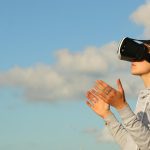This is the companion piece to my last article on mobile data, The dark (and not-so-dark) side of mobile data. The stage is set, were just not quite there yet. When 5G internet becomes a reality, when the mobile data source is unlimited, and when Virtual Reality and Augmented applications proliferate, it wont be that odd to see someone walking down the street with a headset … [Read more...] about How Unlimited Mobile Data and 5G Will Make VR the New Normal
AR / VR
Explore the world of virtual and augmented reality. Discover the latest advancements in VR and AR technology and how they are being used in various industries. Learn how to get started with VR and AR and find resources for further learning.
The Pros And Cons Of Virtual Reality App Development
Virtual reality is a technology that creates an artificial environment. With a few clicks and a headset, users are allowed to build a new world. This innovation is useful in Education, Medicine, Filming, Engineering and other fields of study. Mechanics, Virtual reality app development is a revenue-generating opportunity. Most of the existing VR apps are in the gaming area, but … [Read more...] about The Pros And Cons Of Virtual Reality App Development
How Mixed Reality Will Transform Advertising
Imagine yourself meeting your friend far away from your place at a coffee shop by projecting your digital self and your friend interacting with you, sipping coffee and a virtual kitten thats indistinguishable from a real one playing on the table. Exciting, isnt it? Well, thats what Mixed Reality has in store for you. Before diving deep, lets first understand how its different … [Read more...] about How Mixed Reality Will Transform Advertising
Which Five Business Tech Trends Will Dominate in 2017?
Theres no consensus on when business became all about technology, but it probably happened somewhere around the advent of the cloud. Business went from using technology to being about technology; if your business isnt taking advantage of the latest technology advances, it is an almost irreparable competitive disadvantage. This is the case not just for technology companies, but … [Read more...] about Which Five Business Tech Trends Will Dominate in 2017?
The Top 7 Big Data Trends for 2017
It is the end of the year again and a lot has happened in 2016. Googles AlphGo algorithm beat Lee Se-dol in the game of Go, Blockchain really took off and governments around the globe are investing heavily in smart cities. As every year, I will provide you with the big data trends for the upcoming year, just as I did for 2014, 2015 and 2016. 2017 promises to be a big year for … [Read more...] about The Top 7 Big Data Trends for 2017
What is virtual reality (VR)?
VR is a computer-generated simulation of a three-dimensional environment that can be interacted with in a seemingly real or physical way. VR is typically experienced using a headset and hand controllers, which track the user’s movements and allow them to interact with the virtual environment.
VR can be used for a variety of purposes, such as gaming, training, and entertainment. It has the potential to create immersive and interactive experiences that are not possible in the real world.
What is augmented reality (AR)?
AR is a technology that superimposes digital information or graphics onto the real world, creating a layered experience. AR can be experienced through devices such as smartphones, tablets, or specialized glasses, which use cameras and sensors to track the user’s movements and display the digital content on top of the real world.
AR is used for a variety of applications, including gaming, education, and advertising. It has the potential to enhance the real world with interactive and informative digital content.
What are the differences between VR and AR?
VR creates a fully immersive, computer-generated environment, while AR enhances the real world with digital information. VR requires specialized equipment, such as a headset and hand controllers, to experience, while AR can be accessed through everyday devices such as smartphones.
VR is typically used for fully immersive experiences, while AR is more commonly used for overlaying digital content onto the real world.
What are some examples of VR and AR?
Examples of VR include video games, educational simulations, and virtual tours. Examples of AR include Pokemon Go, Snapchat filters, and interactive museum exhibits. These are just a few examples of the many possible applications of VR and AR, which are being used in a wide range of industries and contexts.
How can I learn more about VR and AR?
There are many resources available for learning about VR and AR on Datafloq, including online courses, books, and industry events. Online courses, such as those offered by Coursera, edX, and Udacity, can provide a comprehensive overview of the technologies and their applications.
There are also many books on VR and AR that cover various aspects of the technologies and their uses. Attending industry events, such as conferences or meetups, can also be a great way to learn about VR and AR and network with others in the field. It is also possible to try out VR and AR experiences at specialized centers or through demos provided by companies that develop VR and AR technology. This can be a great way to get a firsthand experience of what these technologies are capable of.






